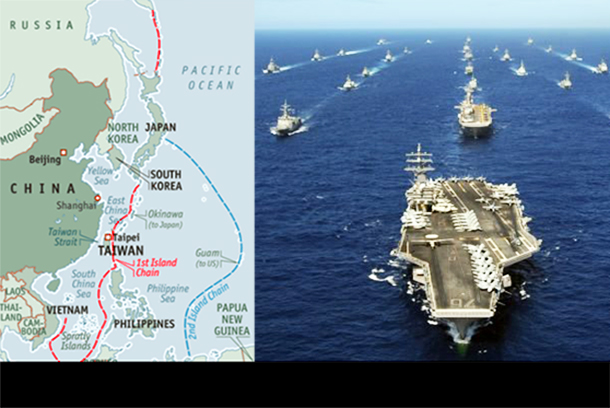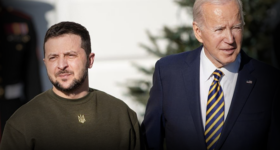
Brian Berletic
21st Century Wire
Tensions between Washington and Beijing are not merely the recent results of former US President Donald Trump’s time in office – but rather just the latest chapter in US efforts to contain China that stretch back decades.
Indeed, US foreign policy has for decades admittedly aimed at encircling and containing China’s rise and maintaining primacy over the Indo-Pacific region.
The “Pentagon Papers” leaked in 1969 would admit in regards to the ongoing US war against Vietnam that:
…the February decision to bomb North Vietnam and the July approval of Phase I deployments make sense only if they are in support of a long-run United States policy to contain China.
The papers also admitted that China, “looms as a major power threatening to undercut [American] importance and effectiveness in the world and, more remotely but more menacingly, to organize all of Asia against [America].
The papers also made it clear that there were (and still are), “three fronts to a long-run effort to contain China: (a) the Japan-Korea front; (b) the India-Pakistan front; and (c) the Southeast Asia front.”
Since then, it is clear that from the continued US military presence in both Japan and South Korea, the now two decades-long US occupation of Afghanistan on both Pakistan’s and China’s borders, and the emergence of the so-called “Milk Tea Alliance” aimed at overthrowing Southeast Asian governments friendly with China and replacing them with US-backed client regimes – this policy to contain China endures up to today.
Assessing US activity along these three fronts reveals the progress and setbacks Washington faces – and various dangers to global peace and stability Washington’s continued belligerence pose.
The Japan-Korea Front
Military.com in their article, “Here’s What It Costs to Keep US Troops in Japan and South Korea,” reports:
In all, more than 80,000 U.S. troops are deployed to Japan and South Korea. In Japan alone, the U.S. maintains more than 55,000 deployed troops — the largest forward-deployed U.S. force anywhere in the world.
The article notes that according to the US Government Accountability Office (GAO), the US spent “$34 billion to maintain military presences in Japan and South Korea between 2016 and 2019.”
The article cites the GAO providing an explanation as to why this massive US military presence is maintained in East Asia:
“…U.S. forces help strengthen alliances, promote a free and open Indo-Pacific region, provide quick response to emergencies and are essential for U.S. national security.”
“Alliances” that are “strengthened” by the physical presence of what are essentially occupying US forces suggests the “alliance” is hardly voluntary and claims of promoting a “free and open Indo-Pacific region” is highly subjective – begging the question of to whom the Indo-Pacific is “free and open” to.
And as US power wanes both regionally in the Indo-Pacific as well as globally, Washington has placed increasing pressure on both Japan and South Korea to not only help shoulder this financial burden, but to also become more proactive within Washington’s containment strategy toward China.
Japan is one of three other nations (the US itself, Australia, and India) drafted into the US-led Quadrilateral Security Dialogue – also know as the “Quad.”
Rather than the US solely depending on its own military forces based within Japanese territory or supported by its Japan-based forces, Japan’s military along with India’s and Australia’s are also being recruited to take part in military exercises and operations in and around the South China Sea.
India’s inclusion in the Quad also fits well into the US 3-front strategy that made up Washington’s containment policy toward China as early as the 1960s.
The India-Pakistan Front
In addition to recruiting India into the Quad alliance, the US helps encourage escalation through political support and media campaigning of India’s various territorial disputes with China.
The US also targets Pakistan’s close and ongoing relationship with China – including the support of armed insurgents in Pakistan’s Baluchistan province.
Recently, a bombing at a hotel in Quetta, Baluchistan appears to have targeted China’s ambassador to Pakistan, Ambassador Nong Rong.
The BBC in its article, “Pakistan hotel bomb: Deadly blast hits luxury venue in Quetta,” would claim:
Initial reports had suggested the target was China’s ambassador. Ambassador Nong Rong is understood to be in Quetta but was not present at the hotel at the time of the attack on Wednesday.
The article also noted:
Balochistan province, near the Afghan border, is home to several armed groups, including separatists. Separatists in the region want independence from the rest of Pakistan and accuse the government and China of exploiting Balochistan, one of Pakistan’s poorest provinces, for its gas and mineral wealth.
Absent from the BBC’s reporting is the extensive and open support the US government has provided these separatists over the years and how – clearly – this is more than just a local uprising against perceived injustice, but yet another example of armed conflict-by-proxy waged by Washington against China.
As far back as 2011 publications like The National Interest in articles like, “Free Baluchistan” would openly advocate expanding US support for separatism in Pakistan’s Baluchistan province.
The article was written by the late Selig Harrison – who was a senior fellow at the US-based corporate-financier funded Center for International Policy – and would claim:
Pakistan has given China a base at Gwadar in the heart of Baluch territory. So an independent Baluchistan would serve U.S. strategic interests in addition to the immediate goal of countering Islamist forces.
Of course, “Islamist forces” is a euphemism for US-Persian Gulf state sponsored militants used to both fight Western proxy wars as well as serve as a pretext for Western intervention. Citing “Islamist forces” in Baluchistan, Pakistan clearly serves as an example of the latter.
In addition to op-eds published by influential policy think tanks, US legislators like US Representative Dana Rohrabacher had proposed resolutions such as (emphasis added), “US House of Representatives Concurrent Resolution 104 (112th): Expressing the sense of Congress that the people of Baluchistan, currently divided between Pakistan, Iran, and Afghanistan, have the right to self-determination and to their own sovereign country.”
There is also funding provided to adjacent, political groups supporting separatism in Baluchistan, Pakistan as listed by the US government’s own National Endowment for Democracy (NED) website under “Pakistan.” Organizations like the “Association for Integrated Development Balochistan” are funded by the US government and used to mobilize people politically, constituting clear interference by the US in Pakistan’s internal political affairs.
The Gwadar Port project is a key juncture within China’s growing global network of infrastructure projects as part of its One Belt, One Road initiative. The US clearly opposes China’s rise and has articulated robust strategies to counter it; everything up to and including open war as seen in the Pentagon Papers regarding the Vietnam War.
The recent bombing in Baluchistan, Pakistan demonstrates that this strategy continues in regards to utilizing local militants to target Chinese-Pakistani cooperation and is one part of the much wider, region-wide strategy of encircling and containing China.
The Southeast Asia Front
Of course the US war against Vietnam was part of a wider effort to reassert Western primacy over Southeast Asia and deny the region from fueling China’s inevitable rise.
The US having lost the war and almost completely retreating from the Southeast Asia region saw Southeast Asia itself repair relations amongst themselves and with China.
Today, the nations of Southeast Asia count China as their largest trade partner, investor, a key partner in infrastructure development, a key supplier for the region’s armed forces, as well as providing the majority of tourism arrivals throughout the region. For countries like Thailand, more tourists arrive from China than from all Western nations combined.
Because existing governments in Southeast Asia have nothing to benefit from by participating in American belligerence toward China, the US has found it necessary to cultivate and attempt to install into power various client regimes. This has been an ongoing process since the Vietnam War.
The US has targeted each nation individually for years. In 2009 and 2010, US-backed opposition leader-in-exile Thaksin Shinawatra deployed his “red shirt” protesters in back-to-back riots – the latter of which included some 300 armed militants and culminated in city-wide arson across Bangkok and the death of over 90 police, soldiers, protesters, and bystanders.
In 2018, US-backed opposition groups took power in Malaysia after the US poured millions of dollars for over a decade in building up the opposition.
Daniel Twining of the US National Endowment for Democracy subsidiary – the International Republican Institute – admitted during a talk (starting at 56 minutes) by the Center for Strategic and International Studies that same year that:
… for 15 years working with NED resources, we worked to strengthen Malaysian opposition parties and guess what happened two months ago after 61 years? They won.
I visited and I was sitting there with many of the leaders the new leaders of this government, many of whom were just our partners we had been working with for 15 years and one of the most senior of them who’s now one of the people running the government said to me, ‘gosh IRI you never gave up on us even when we were ready to give up on ourselves.’
Far from “promoting freedom” in Malaysia – Twining would make clear the ultimate objective of interfering in Malaysia’s internal political affairs was to serve US interests not only in regards to Malaysia, but in regards to the entire region and specifically toward encircling and containing China.
…guess what one of the first steps the new government took? It froze Chinese infrastructure investments.
And that:
[Malaysia] is not a hugely pro-American country. It’s probably never going to be an actual US ally, but this is going to redound to our benefit, and and that’s an example of the long game.
It is a pattern that has repeated itself in Myanmar over the decades with NED money building a parallel political system within the nation and eventually leading to Aung San Suu Kyi and her US-backed National League for Democracy (NLD) party taking power in 2016.
For Myanmar, so deep and extensive is US backing for opposition groups there that elections virtually guarantee US-backed candidates win every single time. The US National Endowment for Democracy’s own website alone lists over 80 programs and organizations receiving US government money for everything from election polling and building up political parties, to funding media networks and “environmental” groups used to block Chinese-initiated infrastructure projects
The move by Myanmar’s military in February this year, ousting Aung Sang Suu Kyi and the NLD was meant to correct this.
However, in addition to backing political groups protesting in the streets, the US has – for many decades – backed and armed ethnic rebels across the country. These rebels have now linked up with the US-backed NLD and are repeating US-backed regime change tactics used against the Arab World in 2011 in nations like Libya, Yemen, and Syria – including explicit calls for “international intervention.”
Watch the following clip from CSIS panel discussion where DC policy operatives admit how the US use ‘democracy promotion’ front organizations like the NED and USAID in order to meddle and gain covert influence over politics in key strategic countries like Malaysia:
A US-Engineered “Asia Spring”
Just as the US did during the 2011 “Arab Spring” – the US State Department, in a bid to create synergies across various regime change campaigns in Asia, has introduced the “Milk Tea Alliance” to transform individual US-backed regime change efforts in Asia into a region-wide crisis.
The BBC itself admits in articles like, “Milk Tea Alliance: Twitter creates emoji for pro-democracy activists,” that:
The alliance has brought together anti-Beijing protesters in Hong Kong and Taiwan with pro-democracy campaigners in Thailand and Myanmar.
Omitted from the BBC’s coverage of the “Milk Tea Alliance” (intentionally) is the actual common denominators that unite it – US funding through fronts like the National Endowment for Democracy and a unifying hatred of China based exclusively on talking points pushed by the US State Department itself.
Circling back to the Pentagon Papers and recalling the coordinated, regional campaign the US sought to encircle China with – we can then look at more recent US government policy papers like the “Indo-Pacific Framework” published in the White House archives from the Trump administration.
The policy paper’s first bullet point asks:
How to maintain US strategic primacy in the Indo-Pacific region and promote a liberal economic order while preventing China from establishing new, illiberal spheres of influence, and cultivating areas of cooperation to promote regional peace and prosperity?
The paper also discusses information campaigns designed to “educate” the world about “China’s coercive behaviour and influence operations around the globe.” These campaigns have materialized in a propaganda war fabricating accusations of “Chinese genocide” in Xinjiang, China, claims that Chinese telecom company Huawei is a global security threat, and that China – not the US – is the single largest threat to global peace and stability today.
In reality US policy aimed at encircling China is predicated upon Washington’s desire to continue its own decades-long impunity upon the global stage and the continuation of all the wars, humanitarian crises, and abuses that have stemmed from it.
Understanding the full scope of Washington’s “competition” with China helps unlock the confusion surrounding unfolding individual crises like the trade war, the ongoing violence and turmoil in Myanmar, bombings in southwest Pakistan, students mobs in Thailand, riots in Hong Kong, and attempts by the US to transform the South China Sea into an international conflict.
Understanding that these events are all connected – then assessing the success or failure of US efforts gives us a clearer picture of the overall success Washington in encircling China. It also gives governments and regional blocs a clearer picture of how to manage policy in protecting against US subversion that threatens national, regional, and global peace and stability.
***
Author Brian Berletic, formerly known under his pen name “Tony Cartalucci,” is Bangkok-based geopolitical researcher, writer and special contributor to 21st Century Wire. See more of his previous work at Tony’s archive. Over the last decade, his work has been published on a number of popular news and analysis websites, and also on the online magazine “New Eastern Outlook”. Also, you can follow him on VK here.
READ MORE CHINA NEWS AT:21st Century Wire China Files
PLEASE HELP SUPPORT OUR INDEPENDENT MEDIA PLATFORM HERE















